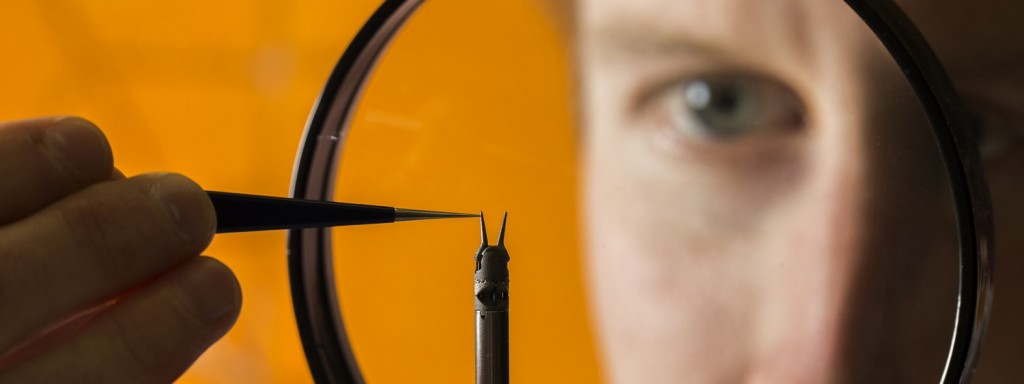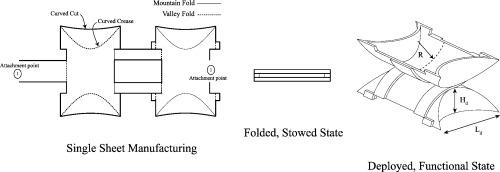 When I was in elementary school, I read a book called Sadako and the Thousand Paper Cranes, which tells the true story of a young Japanese girl who contracted leukemia from the radiation left by the atomic bomb dropped on Hiroshima. According to a Japanese legend, anyone who manages to make 1,000 origami cranes will be granted a wish, and Sadako began folding her cranes in hopes that she could be cured of her leukemia. Tragically, Sadako passed away, but her story has always stayed with me, and it’s what I thought of when I learned of a team of scientists at Brigham Young University who are using the principles of origami to design tiny, 3D printed surgical tools.
When I was in elementary school, I read a book called Sadako and the Thousand Paper Cranes, which tells the true story of a young Japanese girl who contracted leukemia from the radiation left by the atomic bomb dropped on Hiroshima. According to a Japanese legend, anyone who manages to make 1,000 origami cranes will be granted a wish, and Sadako began folding her cranes in hopes that she could be cured of her leukemia. Tragically, Sadako passed away, but her story has always stayed with me, and it’s what I thought of when I learned of a team of scientists at Brigham Young University who are using the principles of origami to design tiny, 3D printed surgical tools.
Origami has actually been used to inspire several innovations in 3D printing and robotics recently. There’s robogami, tiny crawling robots that fold themselves, and folding electronic structures that may improve radio frequency devices. Brigham Young University professors Larry Howell, Spencer Magleby, and Brian Jensen, along with their mechanical engineering students, are now using the ancient Japanese art to create robotic surgical tools that can fit through incisions as small as three millimeters wide.
An incision that small can heal on its own, eliminating the need for sutures – and scars. Not only that, but these tiny robotic tools can allow for more precise and effective surgeries. However, larger tools are needed as well, and that’s where origami comes in. The surgical instruments are designed to be tiny and flat when they are inserted through the incision, but once they are inside the body, they unfold and expand into complex devices such as the D-Core, a tool that, once inside the body, unfolds into two rolling discs that mimic the movement of spinal discs. (You can read more about the D-Core in a study published in Science Direct.)
Howell and Magleby have used the origami concept in their work in other industries, as well. They’ve done a lot of engineering work for NASA, including the creation of a solar array small enough to be stored on a spacecraft, but that expands to 10 times its size once it is launched into space. According to Magleby, the concept is the same for surgical tools.
“Those who design spacecraft want their products to be small and compact because space is at a premium on a spacecraft, but once you get in space, they want those same products to be large, such as solar arrays or antennas,” he said. “There’s a similar idea here: We’d like something to get quite small to go through the incision, but once it’s inside, we’d like it to get much larger.”
 The BYU team is collaborating with Intuitive Surgical, creators of the da Vinci Surgical System, which utilizes a multiple-armed robot to perform minimally invasive surgeries. While the da Vinci system already uses very small tools, surgeons have found that even smaller ones are needed, but traditional design has already gone about as small as it can go. The origami concept not only allows for smaller tools, but it also eliminates the need for extraneous parts like pin joints; the tools are flexible enough to move and bend without them.
The BYU team is collaborating with Intuitive Surgical, creators of the da Vinci Surgical System, which utilizes a multiple-armed robot to perform minimally invasive surgeries. While the da Vinci system already uses very small tools, surgeons have found that even smaller ones are needed, but traditional design has already gone about as small as it can go. The origami concept not only allows for smaller tools, but it also eliminates the need for extraneous parts like pin joints; the tools are flexible enough to move and bend without them.
The researchers have been using 3D printing to prototype the surgical instruments. Not only does 3D printing enable the manufacture of tools with less parts, but it also allows for prototypes to be designed, printed, and taken to the lab in less than a day. This gives the team plenty of room for experimentation with different shapes and constructions; according to Magleby, the goal is not only to make the tools smaller but to make them simpler.
“These small instruments will allow for a whole new range of surgeries to be performed—hopefully one day manipulating things as small as nerves,” Magleby said. “The origami-inspired ideas really help us to see how to make things smaller and smaller and to make them simpler and simpler.”
Origami may not have saved Sadako, but thanks to the creativity of these scientists, it could potentially save many others. Discuss in the 3D Printed Surgical Tools Inspired by Origami forum over at 3DPB.com.
Subscribe to Our Email Newsletter
Stay up-to-date on all the latest news from the 3D printing industry and receive information and offers from third party vendors.
You May Also Like
3D Printing Financials: Fathom Struggles in Financial Quicksand During Critical Transition
Facing a year of key transitions and financial pressures, Fathom (Nasdaq: FTHM) has filed its annual report for 2023 with the U.S. Securities and Exchange Commission (SEC). The document outlines...
Latest Earnings Overview for Australian 3D Printing Firms Titomic and AML3D
Australian 3D printing manufacturing firms Titomic (ASX: TTT) and AML3D (ASX: AL3) reported their financial results for the period from July to December 2023, marking the first half of their...
3D Printing Webinar and Event Roundup: April 7, 2024
Webinars and events in the 3D printing industry are picking back up this week! Sea-Air-Space is coming to Maryland, and SAE International is sponsoring a 3D Systems webinar about 3D...
3D Printing Financials: Unpacking Farsoon and BLT’s 2023 Performance
In the Chinese 3D printing industry, two companies, Farsoon (SHA: 688433) and Bright Laser Technologies, or BLT (SHA: 688333), have recently unveiled their full-year earnings for 2023. Farsoon reported increases...

































